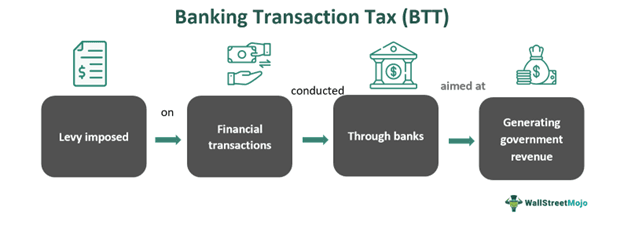Table Of Contents
Banking Transaction Tax (BTT) Meaning
A banking transaction tax (BTT), is a tax imposed on banking transactions. It includes withdrawals, deposits, and transfers that are carried out through recognized banking channels. Transactions through debit and credit cards, mobile banking, and electronic fund transfers are all part of it.

The levy of such taxes is primarily to ease regulatory concerns. The transactions, irrespective of the sources, get taxed and come under the surveillance of the government. Taxes are an income source for the government, and the levy of such taxes reduces the likelihood of monetary fraud. The proceeds are most often directed toward welfare activities.
Key Takeaways
- A banking transaction tax (BTT) is a tax levied on transactions done through the banking system. It is a single-point system that deducts tax at source.
- It may be implemented to increase government revenue or eliminate a variety of complex taxation systems.
- Advantages of BTT include combating black money, growth of digital payments, growth of fair tax habits, room for discretionary spending, etc.
- Disadvantages of the system include the possibility of money laundering by foreign companies and a negative impact on the rural population. Additionally, it is a regressive form of taxation.
Banking Transaction Tax Explained
Banking transaction taxes are those levied on bank account transactions. They are deductions of tax at source and are conceived with the notion of replacing both direct and indirect taxes. The primary advantage of introducing the system is that it unifies taxes. When transactions are taxed as soon as they occur, the process becomes theoretically less complicated. In the case of banking transaction tax rate, the tax levied will be at uniform rates that apply to all transactions. This is irrespective of the fund recipient's income bracket. BTT is often introduced to increase government revenue and promote digital transactions.
The dependency on cash transactions makes it difficult to track the source of funds or the motive of the transaction. This helps build a better, transparent system and improves the country's financial inclusivity. The proceeds from this tax collection can be used similarly to other taxes. It may be used to finance welfare programs, address any budget or fiscal deficit issues, or encourage growth and development in the economy through various initiatives.
Monitoring banking transactions also paves the way for systematic control of the money supply. This aids in combating tax evasion and also controls money flow into the financial markets.
Examples
Let us look into some examples to understand the concept better:
Example #1
Suppose Country XYZ wants to implement a banking transaction tax to fund its infrastructural developmental projects. The country decides to levy a 0.2% banking transaction tax rate on card transactions. Every individual using their credit or debit cards to make transactions will be charged $0.2 for every $100 transaction. This tax may be in addition to existing banking charges. So, if a person has a $10,000 transaction on their card, it will be accompanied by a $20 tax.
Example #2
Banking transaction tax in India was introduced by the then government in 2005. It was implemented as part of direct tax and named banking cash transaction tax under the 2005 Finance Act. It was proposed that transaction tax on cash withdrawals be levied beyond specific limits. The rate fixed was 0.1%, meaning for every 10000-rupee transaction, there was a tax deduction of 10 rupees on the transaction. It was criticized heavily and rolled back in 2009.
How To Levy It?
There aren’t many countries that have dealt with BTT, and the proposed idea of taxation is as follows:
- A single-point tax system is imposed through the banks. They deduct tax at source.
- Deductions will be applied to credits or the amounts received.
- Tax deductions will be credited at specified intervals per varied levels (municipal, federal, or state governments), which may be even daily.
- The transacting bank receives a certain percentage of the benefit.
Advantages And Disadvantages
Given below are some of the advantages and disadvantages of the BTT policy:
Advantages
- It can be an effective mechanism against black money as all receipts go through deduction.
- Growth of government revenue.
- It leaves room for more discretionary spending (as direct taxes may eat up 30% of the income).
- The growth of digital payments results in a transparent and efficient banking system.
- Reduces complex processes and documentation.
- Eliminates the effort and human resources required by the government that will be used for setting up different taxation systems.
- It helps develop fair tax habits among a country's citizens.
Disadvantages
- The concept lacks consideration in terms of income or earnings and taxes on all receipts. Expenses on the receipt are not considered and have several negative implications.
- They adversely affect manufacturing companies that have high revenues and expenses.
- Banks and financial institutions will be taxed for receiving deposits.
- Capital infusion, irrespective of equity or debt, will be taxed.
- Foreign companies whose taxes are deductible outside the country where BTT is imposed will not be subject to this tax, potentially facilitating money laundering.
- Countries that have a majority of rural populations may be affected as they often deal with cash.
- There is no income tax consideration based on salary, and the regressive taxation style may not help people experiencing poverty. This widens the prevailing economic inequality.
- The areas with developed banking institutions or that have a high number of banks will benefit more, and development also varies according to area.
